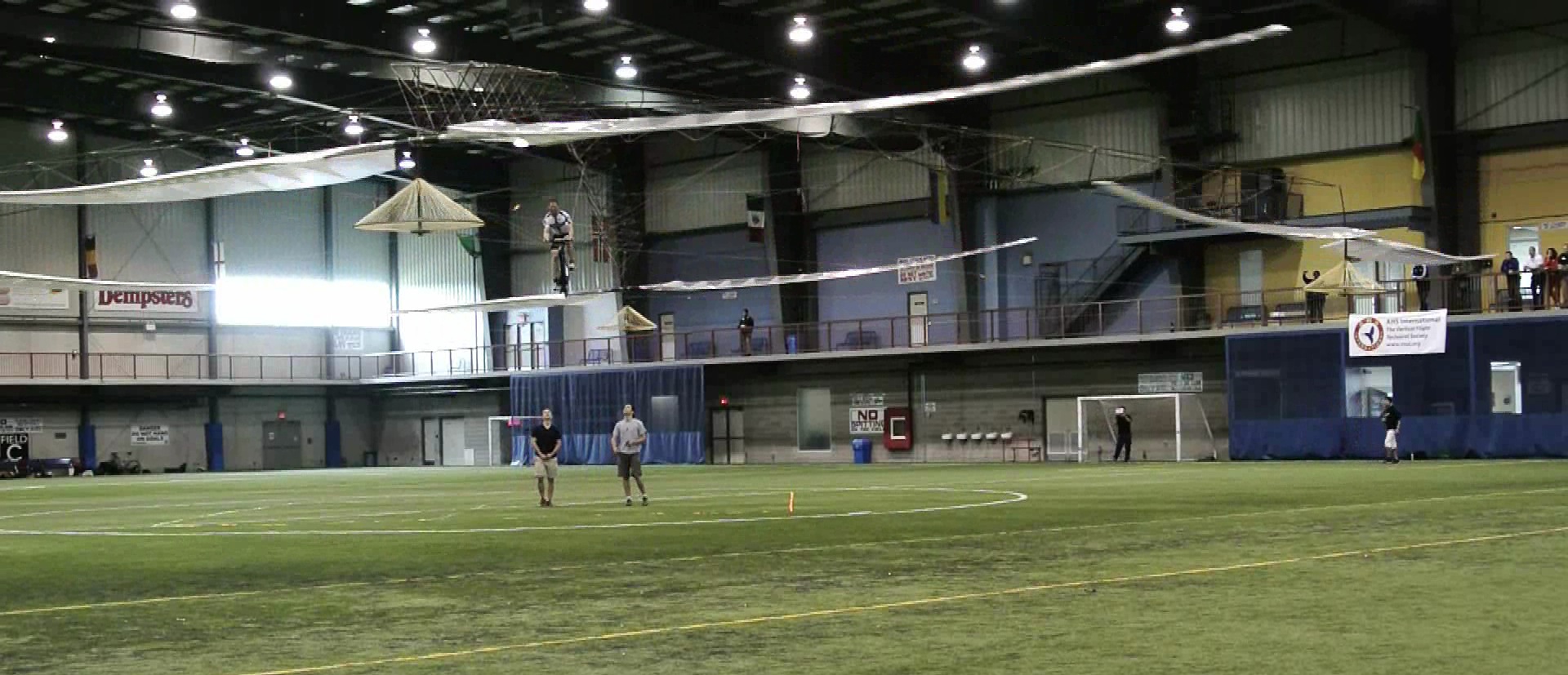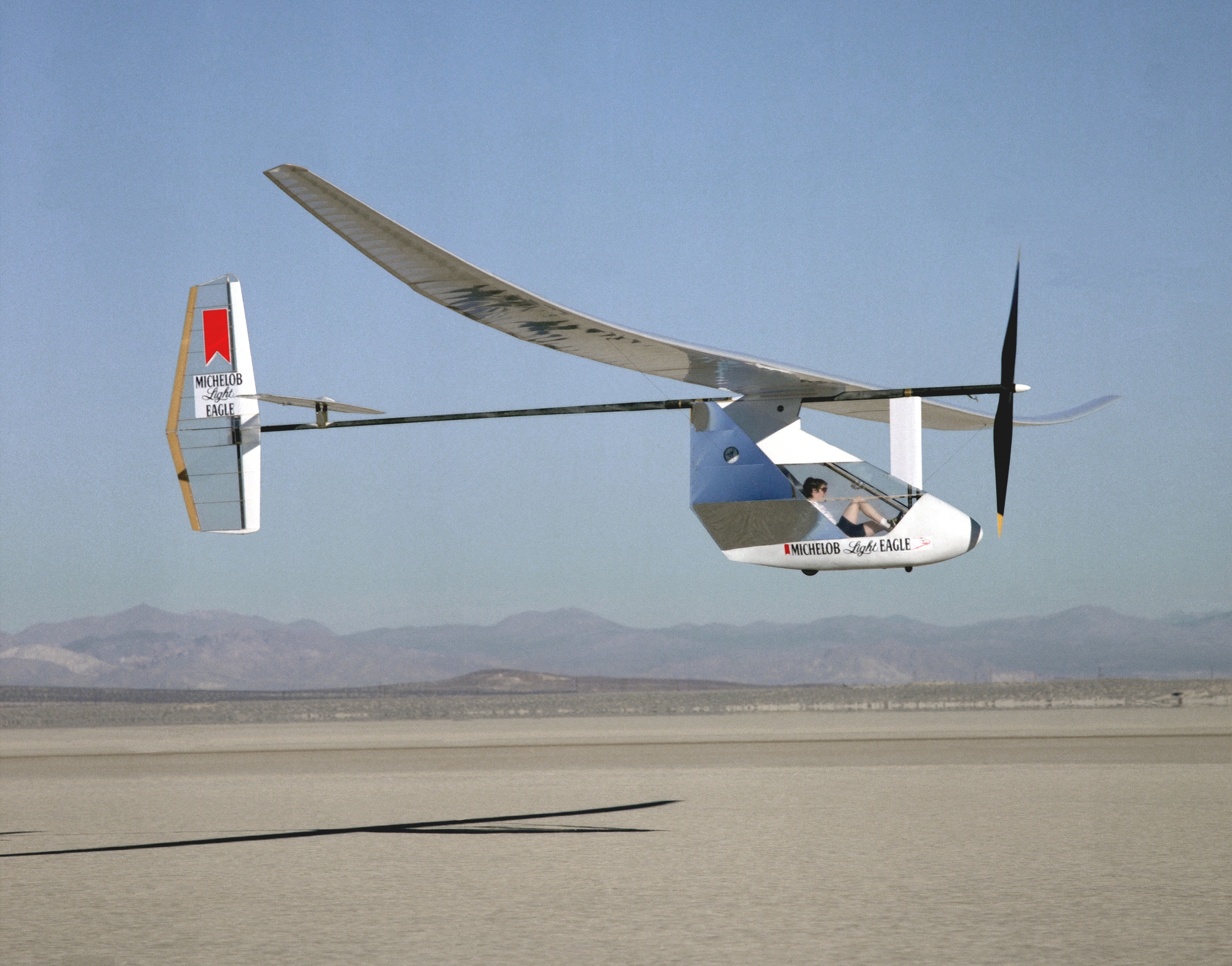|
AeroVelo Atlas
The AeroVelo Atlas is a human-powered helicopter (HPH) that was built for AHS International's Igor I. Sikorsky Human Powered Helicopter Competition. On 13 June 2013, it became the first aircraft to achieve the goals of the competition and thus won the prize. Design and development AeroVelo, a team of students and graduates of the University of Toronto, began flight testing its Atlas quad rotor HPH on 28 August 2012. The core team of AeroVelo is the same group that created Snowbird, the first successful human-powered ornithopter. The Atlas is the largest HPH ever flown, and has a tip-to-tip rotor span of , second only to the Russian Mil V-12. The peak power of was generated only during the first few seconds to climb to the required altitude. By the end of the flight, power had reduced to . Todd Reichert, the pilot and a racing cyclist, had specifically trained for such a power profile. The design specifically took advantage of the ground effect possible by the altitude re ... [...More Info...] [...Related Items...] OR: [Wikipedia] [Google] [Baidu] |
Human-powered Helicopter
A human-powered helicopter (HPH) is a helicopter powered solely by one or more humans carried on board. As in other human-powered aircraft, the power is usually generated by pedalling. It remains a considerable engineering challenge to obtain both the power-to-weight ratio and rotor efficiency required to sustain a helicopter in flight. On 13 June 2013, the AeroVelo Atlas was the first to complete a flight that lasted 64 seconds and reached an altitude of 3.3 meters or 10.82 feet, thus winning the American Helicopter Society (AHS) International's Igor I. Sikorsky Human Powered Helicopter Competition. The AHS Sikorsky Prize The American Helicopter Society (AHS) International's Igor I. Sikorsky Human Powered Helicopter Competition was a competition to achieve the first human-powered helicopter flight to reach an altitude of 3 m (10 ft) during a flight lasting at least 60 seconds, while remaining within a 10 m (32.8 ft) x 10 m (32.8 ft) square, and ... [...More Info...] [...Related Items...] OR: [Wikipedia] [Google] [Baidu] |
Aviation Week
''Aviation Week & Space Technology'', often abbreviated ''Aviation Week'' or ''AW&ST'', is the flagship magazine of the Aviation Week Network. The weekly magazine is available in print and online, reporting on the aerospace, defense and aviation industries, with a core focus on aerospace technology. It has a reputation for its contacts inside the United States military and industry organizations. ''Aviation Week'' was a favorite conduit for defense-related companies and labs to leak information to the public as part of their policy by press release efforts. This led to it being informally referred to "Aviation Leak and Space Mythology". History The magazine was first published in August 1916. Early editors Ladislas d'Orsy and Donald W. McIlhiney (1921 to 25) were Quiet Birdmen. Publisher (1927 to 29) Earl D. Osborn was also a Quiet Birdman. With the coming of the Space Age, the current title was adopted in 1960. Other titles the magazine has held include ''Aviation & Aircraft ... [...More Info...] [...Related Items...] OR: [Wikipedia] [Google] [Baidu] |
2010s Canadian Experimental Aircraft
1 (one, unit, unity) is a number representing a single or the only entity. 1 is also a numerical digit and represents a single unit of counting or measurement. For example, a line segment of ''unit length'' is a line segment of length 1. In conventions of sign where zero is considered neither positive nor negative, 1 is the first and smallest positive integer. It is also sometimes considered the first of the infinite sequence of natural numbers, followed by 2, although by other definitions 1 is the second natural number, following 0. The fundamental mathematical property of 1 is to be a multiplicative identity, meaning that any number multiplied by 1 equals the same number. Most if not all properties of 1 can be deduced from this. In advanced mathematics, a multiplicative identity is often denoted 1, even if it is not a number. 1 is by convention not considered a prime number; this was not universally accepted until the mid-20th century. Additionally, 1 is the s ... [...More Info...] [...Related Items...] OR: [Wikipedia] [Google] [Baidu] |
Human-powered Aircraft
A human-powered aircraft (HPA) is an aircraft belonging to the class of vehicles known as human-powered transport. Human-powered aircraft have been successfully flown over considerable distances. However, they are still primarily constructed as engineering challenges rather than for any kind of recreational or utilitarian purpose. History Early attempts at human-powered flight were unsuccessful because of the difficulty of achieving the high power-to-weight ratio. Prototypes often used ornithopter principles which were not only too heavy to meet this requirement but aerodynamically unsatisfactory. First attempts In 1904, Scientific American published an article and a photograph of a bicycle plane built by Steward Winslow of Riparia, Washington. He attempted to fly his plane on 30 July 1904, but one of the wheels failed. An early human-powered aircraft was the Gerhardt Cycleplane, developed by W. Frederick Gerhardt at McCook Field in Dayton, Ohio in 1923. The aircraft h ... [...More Info...] [...Related Items...] OR: [Wikipedia] [Google] [Baidu] |
University Of Maryland Gamera II Human-powered Helicopter
The University of Maryland Gamera II is an improved human-powered helicopter designed to win the US$250,000 Sikorsky Prize. Development The Gamera II is a quadrotor helicopter purpose-designed to attempt an official flight duration record sanctioned by the National Aeronautic Association, and is a step in the progression of designs built to meet the criteria of the 1980 American Helicopter Society Igor I. Sikorsky Human Powered Helicopter Competition. It is the advanced follow-on model of the Gamera I developed the year prior. Two other teams have made Sikorsky Prize attempts unsuccessfully. On June 13, 2013, the University of Toronto Team's AeroVelo Atlas, managed to keep its helicopter in the air for 64.11 seconds, reach a peak altitude of 3.3 meters and drift no more than 9.8 meters from the starting point, claiming the prize. The requirements to win the Sikorsky Prize include achieving a flight duration of 60 seconds and reaching an "altitude" of . At the same time the ai ... [...More Info...] [...Related Items...] OR: [Wikipedia] [Google] [Baidu] |
New England Air Museum
The New England Air Museum (NEAM) is an American aerospace museum located adjacent to Bradley International Airport in Windsor Locks, Connecticut. The museum consists of three display hangars with additional storage and restoration hangars. Its collections include aircraft ranging from early flying machines to supersonic jets, as well as engines, and other pieces of flight-related equipment. Significant aircraft include * the Silas Brooks balloon basket - the oldest surviving American-built aircraft * the Sikorsky VS-44A - the sole remaining American-built commercial trans-oceanic four-engine flying boat * the Goodyear ZNPK-28 Blimp Control Car - one of only two surviving K-class control cars in the world. The museum library has approximately 6,000 aviation books, approximately 20,000 periodicals, approximately 10,000 technical manuals, approximately 21,000 photographs, nearly 8,000 slides, over 200 pieces of artwork, over 1,200 prints, and approximately 500 engineering drawing a ... [...More Info...] [...Related Items...] OR: [Wikipedia] [Google] [Baidu] |
Wired (magazine)
''Wired'' (stylized as ''WIRED'') is a monthly American magazine, published in print and online editions, that focuses on how emerging technologies affect culture, the economy, and politics. Owned by Condé Nast, it is headquartered in San Francisco, California, and has been in publication since March/April 1993. Several spin-offs have been launched, including '' Wired UK'', ''Wired Italia'', ''Wired Japan'', and ''Wired Germany''. From its beginning, the strongest influence on the magazine's editorial outlook came from founding editor and publisher Louis Rossetto. With founding creative director John Plunkett, Rossetto in 1991 assembled a 12-page prototype, nearly all of whose ideas were realized in the magazine's first several issues. In its earliest colophons, ''Wired'' credited Canadian media theorist Marshall McLuhan as its "patron saint". ''Wired'' went on to chronicle the evolution of digital technology and its impact on society. ''Wired'' quickly became recognized ... [...More Info...] [...Related Items...] OR: [Wikipedia] [Google] [Baidu] |
Helicopter Rotor
A helicopter main rotor or rotor system is the combination of several rotary wings (rotor blades) with a control system, that generates the aerodynamic lift force that supports the weight of the helicopter, and the thrust that counteracts aerodynamic drag in forward flight. Each main rotor is mounted on a vertical mast over the top of the helicopter, as opposed to a helicopter tail rotor, which connects through a combination of drive shaft(s) and gearboxes along the tail boom. The blade pitch is typically controlled by the pilot using the helicopter flight controls. Helicopters are one example of rotary-wing aircraft (rotorcraft). The name is derived from the Greek words ''helix'', helik-, meaning spiral; and ''pteron'' meaning wing. Design principles Overview The helicopter rotor is powered by the engine, through the transmission, to the rotating mast. The mast is a cylindrical metal shaft that extends upward from—and is driven by—the transmission. At the top of the mast i ... [...More Info...] [...Related Items...] OR: [Wikipedia] [Google] [Baidu] |
Helicopter
A helicopter is a type of rotorcraft in which lift and thrust are supplied by horizontally spinning rotors. This allows the helicopter to take off and land vertically, to hover, and to fly forward, backward and laterally. These attributes allow helicopters to be used in congested or isolated areas where fixed-wing aircraft and many forms of STOL (Short TakeOff and Landing) or STOVL (Short TakeOff and Vertical Landing) aircraft cannot perform without a runway. In 1942, the Sikorsky R-4 became the first helicopter to reach full-scale production.Munson 1968.Hirschberg, Michael J. and David K. Dailey"Sikorsky". ''US and Russian Helicopter Development in the 20th Century'', American Helicopter Society, International. 7 July 2000. Although most earlier designs used more than one main rotor, the configuration of a single main rotor accompanied by a vertical anti-torque tail rotor (i.e. unicopter, not to be confused with the single-blade monocopter) has become the most comm ... [...More Info...] [...Related Items...] OR: [Wikipedia] [Google] [Baidu] |
Ground Effect (aircraft)
For fixed-wing aircraft, ground effect is the reduced aerodynamic drag that an aircraft's wings generate when they are close to a fixed surface.. Reduced drag when in ground effect during takeoff can cause the aircraft to "float" while below the recommended climb speed. The pilot can then fly just above the runway while the aircraft accelerates in ground effect until a safe climb speed is reached.. For rotorcraft, ground effect results in less drag on the rotor during hovering close to the ground. At high weights this sometimes allows the rotorcraft to lift off while stationary in ground effect but does not allow it to transition to flight out of ground effect. Helicopter pilots are provided with performance charts which show the limitations for hovering their helicopter in ground effect (IGE) and out of ground effect (OGE). The charts show the added lift benefit produced by ground effect. For fan- and jet-powered vertical take-off and landing (VTOL) aircraft, ground effect when ... [...More Info...] [...Related Items...] OR: [Wikipedia] [Google] [Baidu] |








